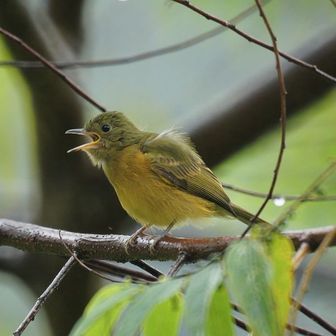Ochre-bellied Flycatcher
The Ochre-bellied Flycatcher, Mionectes oleagineus, is a small bird of the tyrant flycatcher family. It breeds from southern Mexico through Central America, and South America east of the Andes as far as southern Brazil, and on Trinidad and Tobago.

Original source: Mike & Chris
Author: Mike & Chris
The Ochre-bellied Flycatcher is classified as Least Concern. Does not qualify for a more at risk category. Widespread and abundant taxa are included in this category.
The Ochre-bellied Flycatcher, Mionectes oleagineus, is a small bird of the tyrant flycatcher family. It breeds from southern Mexico through Central America, and South America east of the Andes as far as southern Brazil, and on Trinidad and Tobago. This is a common bird in humid forests, usually in undergrowth near water. It makes a moss-covered ball nest with a side entrance, which is suspended from a root or branch, often over water. More
The Ochre-bellied Flycatcher, Mionectes oleagineus, is a small bird of the tyrant flycatcher family. This species was previously placed in the genus Pipromorpha. Distribution / Range: It breeds from southern Mexico through Central America, and South America east of the Andes as far as southern Brazil, and on Trinidad and Tobago. This is a common bird in humid forests, usually in undergrowth near water. More
Ochre-bellied Flycatcher determination Similar species Tyrannidae Amazonian Royal Flycatcher | Bearded Tachuri | Black-capped Becard | Black-chested Tyrant | Black-crowned Tityra | Black-tailed Tityra | Boat-billed Flycatcher | Boat-billed Tody-Tyrant | Bran-coloured Flycatcher | Brown-crested Flycatcher | Cinereous Becard | Cinereous Mourner | Cinnamon Attila | Cinnamon-crested Spadebill | Cliff Flycatcher | Common Tody-Flycatcher | Double-banded Pygmy-tyrant | Drab Water-Tyrant More
Ochre-bellied Flycatcher assimilis Mionectes oleagineus assimilis P L Sclater, 1859 Distribution: Tropical s Mexico to e Costa Rica and Panama (Bocas del Toro) (Map) Taxon info Pictures On Internet Who X? Dist. References: James F. Clements. More
to the Ochre-bellied Flycatcher, not only in appearance but also in behavior. show section Reproduction During the mating season, the males sing and display themselves to the females in groups (leks), though there is normally little contact or interaction among the participating birds. Nest is a leafy ball with a side entrance, suspended from a twig above small waters. Clutch size is 3 eggs, incubated for about 19 days. The young fledge 1-20 days after hatching of last egg. More
Family : Tyrannidae
Genus : Mionectes
Species : oleagineus
Authority : (Lichtenstein, 1823)

